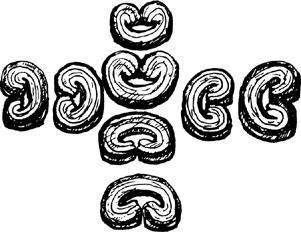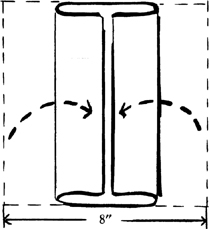Mastering the Art of French Cooking, Volume 2 (204 page)
Read Mastering the Art of French Cooking, Volume 2 Online
Authors: Julia Child

Sugar (ordinary granulated sugar)
A flexible-blade spatula
A clean dry baking sheet
A rack or racks
Spread an oval-shaped layer of sugar ⅛ inch thick on your rolling surface. Lay a pastry cutout on the
sugar and roll it out into a tongue shape 6 to 7 inches long and about
1
⁄
16
inch thick; you will be encrusting sugar into the bottom of the pastry as you roll. Turn it upside down, sprinkle on more sugar, and set on baking sheet. Continue with the rest of the cutouts. (Although you can bake the cookies now, they usually cook more evenly if you cover with plastic wrap and chill them for half an hour at least; this relaxes the dough and prevents it from shrinking or pulling out of shape during baking.)
2)
Baking—oven has been preheated to 450 degrees
Bake in upper-middle level of preheated oven for 7 to 8 minutes, until sugar coating has caramelized lightly; if some cookies are done before others, remove them to rack because they burn easily. Cookies crisp as they cool.
(*)
Couques
will stay crisp for several days in dry weather when stored airtight; otherwise keep them in a warming oven or freeze them.
PALMIERS
[Palm-leaf Caramelized Sugar Cookies Made from Puff Pastry Dough]
This most popular of all puff-pastry cookies is often a disappointment when store-bought, even in France, but always delicious when you make it yourself from your own homemade buttery puff pastry. Thus if you have not been impressed with them before, try making your own; you will find them handsome to look at, wonderfully crisp, and you may make them very large as well as rather small. Size depends on the thickness of the pastry and the width of the rectangle you roll it into. You will work out your own system if you become an addicted
pâtissier
of
palmiers
, with your own palm-leaf patterns and special
tours de main;
we suggest only the basic techniques here. Again, we shall not give proportions, but a piece of pastry dough 5½ by 2 by 1½ inches will produce 2 dozen 3-inch
palmiers
.
1)
Forming the cookies
Chilled leftover French puff pastry,
pâte feuilletée
Sugar (ordinary granulated sugar)
A flexible-blade spatula
A clean dry baking sheet (you will probably need 2 sheets at least)
A rack or racks
Spread a layer of sugar ⅛ inch thick on your rolling surface. Sprinkling dough with more sugar as you roll, extend it into a rectangle about
3
⁄
16
inch thick. Fold bottom up to middle, and top down to cover it, as though folding a business letter. (Illustrations are in
Puff Pastry
.)
Turn pastry so top flap of dough is to your right, roll again in sugar to make a rectangle ⅜ inch thick, and fold again in three. (If pastry has softened and become difficult to handle, or if it has stiffened and become balky, refrigerate for 30 minutes to an hour, then continue.) Roll the dough out 8 inches long (for 3-inch
palmiers
), then give it a quarter turn so the 8-inch length is facing you. Extend it out in front of you now with your rolling pin, keeping the dough 8 inches wide, and rolling it to whatever length it will go to make a square or rectangle ¼ inch thick. Trim off rough edges.
Fold sides so they almost touch at the center, as shown |
|
| Fold pastry in two, as though closing a book |






